Asia
Cold wave and fog cause chaos in India
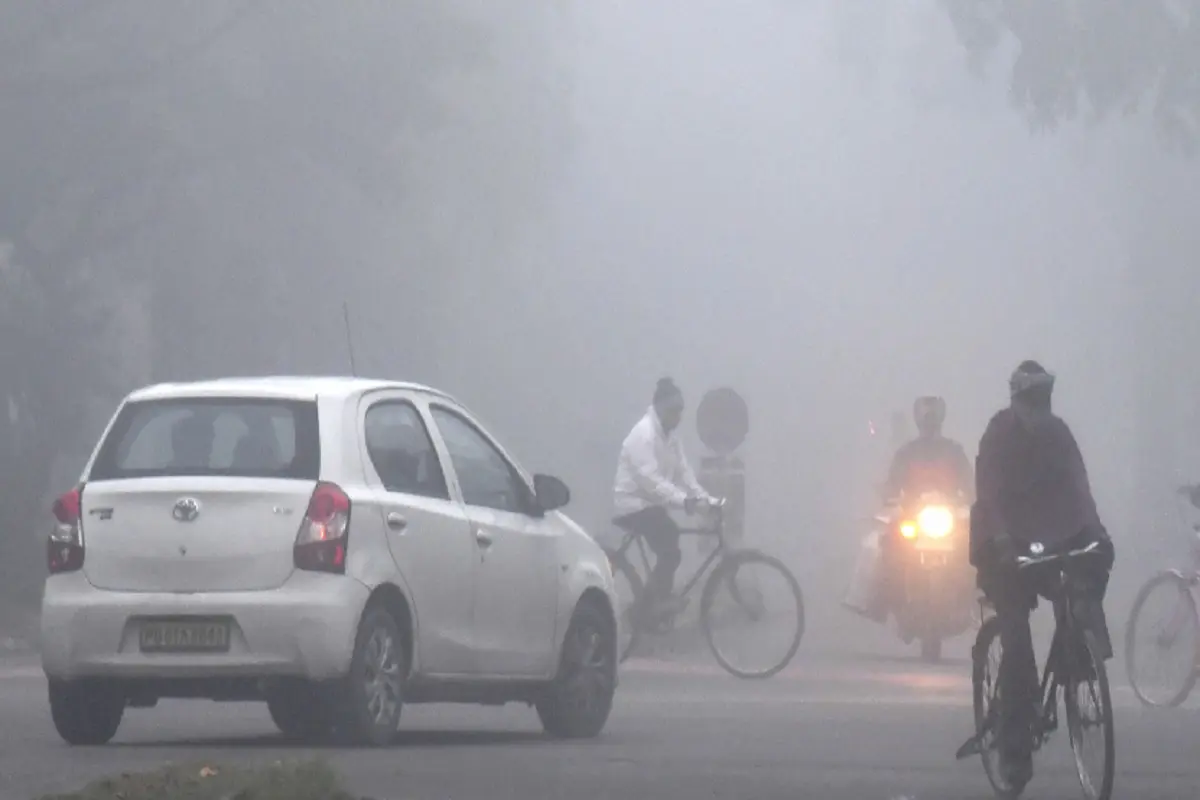
The India Meteorological Department (IMD) had warned of very dense fog and cold weather conditions over northwest India that could last for upcoming days. The department had also warned of breathing issues in some vulnerable patients. Those people going through asthma and bronchitis ailments may suffer from shortness of breath, wheezing and coughing. It has also predicted a tripping of power lines due to the weather conditions and other difficulties like vehicle collisions etc…
On Monday, a severe cold day was observed in New Delhi, the capital city. With the thick fog blanketing Delhi, the department forecasts “defense to very dense fog conditions across Punjab, Haryana and Chandigarh to persist.”
Dense fog has already caused delays in rail and air travel in the country’s north, which is also experiencing a severe cold wave. The air quality in Delhi and surrounding areas remained poor, and IDM reported a minimum temperature of 1.9 degree Celsius in the Safdarjung neighborhood of Delhi. The city has been blanked by the heavy layer of fog on Monday morning.
Lower visibility has also hampered flight and train operations in northern parts of the country. Indian Northern Railway has confirmed 42 trains were delayed to New Delhi. Meanwhile, Delhi International Airport Limited said that severe fog may impede airport operations. “Passengers are requested to contact the airline concerned for updated flight information,” it said in a statement.
Moreover, local broadcaster reported that poor weather caused disruption at Delhi airport, with over 140 flights delayed. Authorities in Delhi also asked schools to extend winter holidays and canceled classes.
Avoid outdoor activities
The Indian authorities also asked the people to avoid or limit outdoor activities until the weather conditions improve and called on the citizens to pay attention while driving through dense fog.
The harsh cold time could be expected to cause more health issues, especially in Delhi and winter season is particularly hard for India’s homeless population. These people are often sleeping beside the road and at railway stations, and on Sunday, Delhi had experienced the foggiest days so far this winter.
The foggy conditions also continued on Monday and the vehicles were seen driving slowly and carefully. Domestic airline IndiGo had said that flight timings were affected due to dense fog and poor visibility in Delhi, advising passengers to check their flight status before leaving for the airport.
To beat the cold, people were also seen huddled around large bonfires near gas stations and on street corners.
Flights diverted and trains canceled
On Monday, three flights were diverted to Jaipur instead of landing in Delhi due to very dense fog and low visibility. Two of the three flights that have been diverted are SpiceJet and one is Air India Express, WION reported, citing officials from Delhi airport.
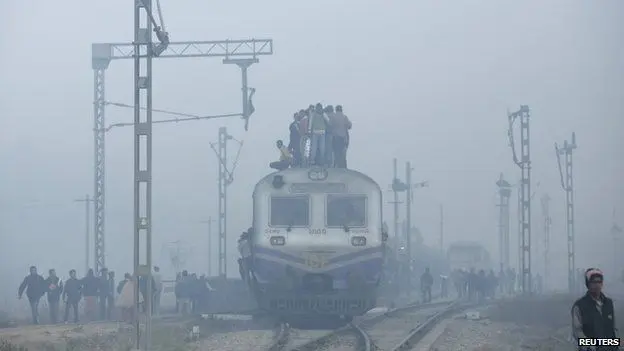
Northern India is in the grip of a cold snap and heavy fog. Reuters
Meanwhile a total of 267 trains were canceled due to fog and other conditions. “Till 11am, a total of 170 trains were running late and out of 170 trains, 91 trains (54%) were running late due to weather conditions,” the Railways said in a statement, according to ANI.
Schools were also ordered to close until 15 January.
Nearly 100 people die
At least 98 people have died in Kanpur, Uttar Pradesh, owing to heart and brain strokes in the past five days.
At least six patients died while receiving treatment at the Institute of Heart Disease, and fourteen patients who had been suffering from a severe cold passed away from a heart attack. According to the Institute, eight other people were brought dead to the institute.
At the city’s SPS Heart Institute, 14 people died in the last 24 hours, according to WION. The doctors believe that the sudden blood pressure spikes brought on by the cold and blood clotting, are triggering heart and brain attacks. The patients were advised to protect themselves from the cold waves.
“Heart attacks in this cold weather are not restricted only to the elderly,” a faculty member at King George’s Medical University (KGMU) in Lucknow said, IANS reported.
He said that they have got cases when even teenagers have suffered heart attacks. “Everyone, irrespective of age, should keep warm and stay indoors as far as possible,” he suggested.
Three foreigners killed as bus hits truck amid fog
Three Nepalese citizens and one Indian “driver” were killed after a Nepal-bound bus rammed into a truck on the Agra-Lucknow Expressway in the midst of a dense fog cover over Unnao in Uttar Pradesh on Monday.
Another six passengers, including four Nepalese received injuries in the incident and were evacuated to the hospital. The bus was carrying 60 passengers and they were going from Rajkot in Gujarat to Nepal.
Additional Superintendent of Police Shashi Shekhar Singh said a blinding fog cover engulfed a large part of the state this morning, lowering the visibility considerably, according to the Telegraph Online.
Singh said that the bus hit the truck from behind on the Agra-Lucknow Expressway around 5.30 am.
Asia
ASEAN and China deepen ties amid threat of new US tariffs
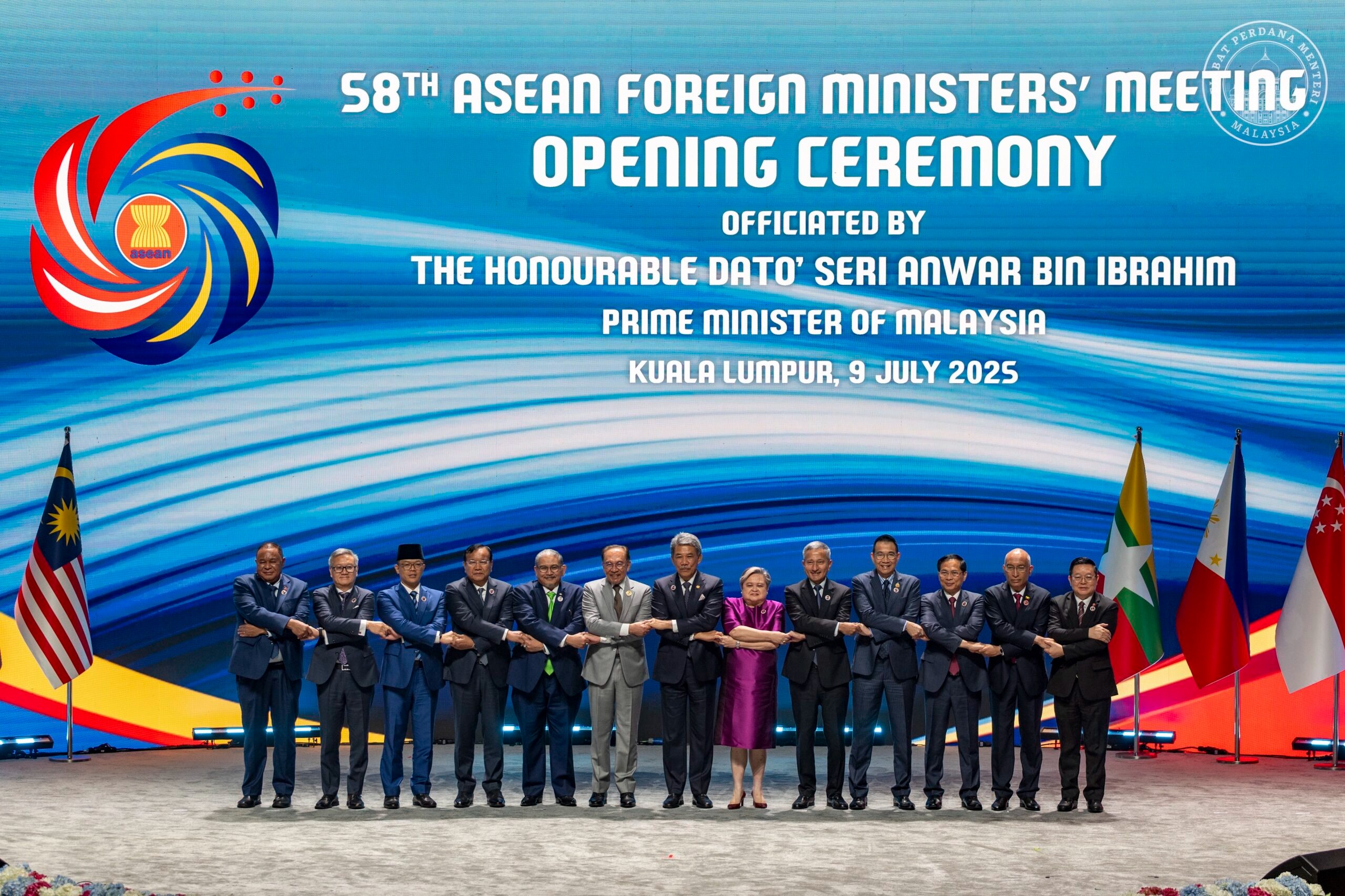
On Thursday, ASEAN foreign ministers emphasized the strength of the bloc’s relationship with China as they sought to deepen ties with Beijing in the face of new “reciprocal” punitive tariffs threatened by US President Donald Trump. Experts believe Trump’s aggressive tariff policy is bringing ASEAN and China even closer.
In his opening speech at a meeting in Kuala Lumpur with ASEAN foreign ministers and their Chinese counterpart, Wang Yi, Malaysian Foreign Minister Mohamad Hasan said that China is “one of ASEAN’s most important and dynamic partners.”
“This relationship is built on mutual trust, common interests, and growing economic interdependence,” he said.
Wang echoed these sentiments, emphasizing the countries’ shared Asian identity and goals. “China has always seen ASEAN as a priority in its neighborhood diplomacy and sees the region as a pioneer in building a global community with a shared future for humanity,” he said.
The meeting was part of the annual Ministerial Conference of ASEAN foreign ministers. Following the meeting, there will be meetings with Japan, China, and South Korea, as well as with US Secretary of State Marco Rubio and other dialogue partners.
Addressing the ongoing geopolitical shifts, Wang noted that the current global turmoil and transformation raise questions of unity or division, peace or conflict, and cooperation or confrontation.
“We must learn from history, actively promote an equal and structured world order, and push the international system toward greater justice and equality by supporting inclusive and shared economic globalization,” he said.
Trade relations
Since 2020, ASEAN and China have remained each other’s largest trading partners, with total trade volume reaching $770.9 billion in 2024, a 10.6% increase from the previous year.
In May, the two sides announced the ASEAN-China Free Trade Area (ACFTA) 3.0 agreement after nine rounds of negotiations spanning two and a half years.
The upgraded agreement includes nine new chapters covering the digital economy, green economy, and supply chain connectivity. China’s Ministry of Commerce described this framework as a gateway to building the China-ASEAN mega-market.
Meanwhile, ASEAN members are preparing for new US tariffs set to take effect on August 1. The tariffs are set at 40% for Myanmar and Laos, 36% for Cambodia and Thailand, 32% for Indonesia, 25% for Malaysia and Brunei, and 20% for Vietnam and the Philippines. Washington has not yet announced an updated rate for Singapore, which was taxed at a 10% rate when the tariffs were announced in April.
Response to tariffs
On Wednesday, at the start of the ASEAN foreign ministers’ meeting, Malaysian Prime Minister Anwar Ibrahim stated that trade is being used as a tool for “pressure, isolation, and control,” adding that “tariffs, export restrictions, and investment barriers have now become sharp instruments of geopolitical competition.”
In a speech to parliament on Wednesday, Indonesian Finance Minister Sri Mulyani called for multilateral institutions such as the World Trade Organization, the UN, and the World Bank to play a more significant role in the trade war. “The role of these multilateral institutions has been greatly weakened and is not even respected,” she said.
Thailand announced $1.22 billion in mitigation measures. According to Deputy Finance Minister Paopoom Rojanasakul, Thailand’s central bank is also expected to further loosen its monetary policy to reduce tariffs.
A draft of the joint communique from the foreign ministers’ meeting, seen by Nikkei Asia, describes unilateral tariffs as “counterproductive” and warns that they “risk exacerbating global economic fragmentation and posing complex challenges to ASEAN’s economic stability and growth.” The draft, expected to be released on Friday, affirms that ASEAN is “committed to working constructively with all partners to this end.”
Asia
Chinese navy chief and top nuclear scientist expelled from legislature

The chief of staff for the People’s Liberation Army (PLA) Navy, Vice Admiral Li Hanjun, and Liu Shipeng, the deputy chief engineer of the state-owned China National Nuclear Corporation, were removed from their positions in the country’s legislative body.
Li is the latest in a series of PLA generals and a handful of defense industry executives implicated in a widespread investigation within the military.
In a statement on Friday, the NPC Standing Committee announced, “The Navy Soldiers’ Congress has decided to remove Li Hanjun from his post as a representative to the 14th National People’s Congress.”
The Gansu People’s Congress also dismissed Liu Shipeng from his role as an NPC deputy.
Additionally, the Standing Committee revealed it had voted to remove Miao Hua, a former top general who previously oversaw the PLA’s ideological work, from the Central Military Commission (CMC), China’s highest military command body led by President Xi Jinping.
The removal of Li and Liu from their NPC memberships suggests they are facing serious disciplinary action.
China typically remains silent about purges within the military, and announcements from the NPC are one of the few indicators of such campaigns.
There is little public information available about Li and Liu, as both have worked in sensitive positions.
Before becoming the navy’s chief of staff, Li, 60, was the deputy director of the CMC’s Training and Administration Department. He was appointed to this role after serving for a year in the CMC’s Office for Reform and Organisational Structure.
In 2014, he was promoted to vice admiral upon his appointment as commander of the naval base in Fujian province, where Miao also spent a significant part of his career. At that time, he was the director of training at the China Naval Command College and was soon promoted to president of the school.
According to official media reports, nuclear scientist Liu was born into a family that “served China’s nuclear dream for three generations.”
As the deputy chief engineer at CNNC, which oversees all aspects of China’s civil and military nuclear programs, Liu also served as the Communist Party secretary and president of CNNC’s “404 base” in Gansu.
Covering an area of over 1,000 square kilometers, the base was established in 1958 and is the country’s first and largest nuclear research center. It played a crucial role in the development of China’s first atomic bomb in 1964 and its first hydrogen bomb three years later.
This secretive base is still considered a key hub for China’s nuclear deterrence and nuclear industry.
According to statements from provincial authorities, Liu was named “Gansu’s outstanding entrepreneur” in 2023.
Asia
China, US reach agreement on export controls

The Chinese Ministry of Commerce announced on Friday afternoon that Beijing and Washington have remained in close contact since the two-day trade talks in London earlier this month, confirming the details of a framework agreement.
“China will review and approve export applications for controlled items in accordance with its laws and regulations, and the US side will, in turn, lift a series of restrictive measures against China,” the ministry stated.
“We hope the US side will cooperate with China in line with the important consensus and conditions established during the conversation between the two presidents on June 5,” the statement continued.
On Thursday, US President Donald Trump said the US had “signed” a trade deal with China the previous day, without providing details.
“We signed the deal with China yesterday, right? We signed the deal with China,” Trump said at a White House event introducing a budget law. “With the China deal, we are starting to open up China,” he added.
He also mentioned that a “very big” deal, likely with India, would be signed soon.
Rare earth elements
Following the event, US Commerce Secretary Howard Lutnick told reporters that the US and China had signed an agreement codifying the terms decided upon in previous trade negotiations.
“They will deliver rare earth elements to us,” Lutnick said in a televised interview with Bloomberg, adding that if this commitment is fulfilled, Washington will lift its “countermeasures.”
Rare earth elements, essential for producing high-tech products, including those for the defense industry, were a major point of contention in the trade talks. China holds a near-monopoly on the supply of these minerals due to its massive share of global refining capacity.
Responding to a question on Thursday about rare earth exports, ministry spokesman He Yadong said China had approved a “certain number” of applications and would “continue to strengthen” the review and approval process for eligible applications.
He added that Beijing is willing to “strengthen communication and dialogue” with other countries on export controls and actively promote appropriate trade.
Lutnick also stated that the US plans to reach agreements with 10 major trading partners in the coming weeks. The deadline for countries to negotiate trade terms before higher tariffs are reinstated was July 9, following a 90-day suspension of import tariff hikes announced on April 2.
The two negotiating teams concluded the London talks by announcing they had agreed “in principle” on a “framework” that both sides would take home for their respective leaders to review, as they sought to get their uneasy truce, signed last month in Geneva, back on track.
The negotiations began after a highly anticipated phone call between Xi Jinping and Trump, which seemingly ended an intractable stalemate.
In the weeks following the initial agreement in Switzerland, Washington claimed China was restricting exports of critical minerals, while Beijing reacted to US restrictions on semiconductors and threats to impose visa barriers on Chinese students.
-

 Diplomacy2 weeks ago
Diplomacy2 weeks agoBRICS internal trade volume hits the $1 trillion mark
-
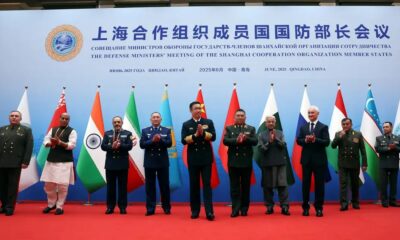
 Asia2 weeks ago
Asia2 weeks agoChina hosts SCO defense ministers on warship amid regional tensions
-

 Europe2 weeks ago
Europe2 weeks agoNew MI6 chief’s grandfather was a Nazi collaborator known as ‘The Butcher’
-

 Europe2 weeks ago
Europe2 weeks agoWeber warns against US dominance, urges European self-confidence
-

 America2 weeks ago
America2 weeks agoUS intelligence officials claim Iran’s nuclear facilities were destroyed
-
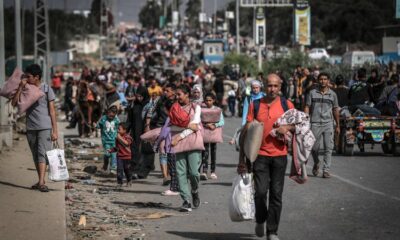
 Middle East2 days ago
Middle East2 days agoIsrael details plan for ‘humanitarian zone’ in Rafah, called a ‘concentration camp’ by critics
-
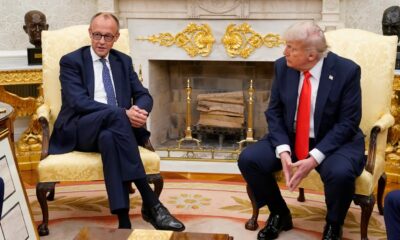
 Europe2 weeks ago
Europe2 weeks agoMerz urges Brussels to secure a US trade deal within days
-
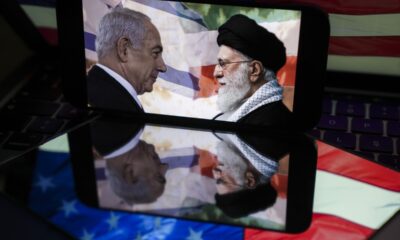
 Interview2 weeks ago
Interview2 weeks agoWho won the Israel-Iran war? Retired Rear Admiral Alaettin Sevim speaks to Harici








